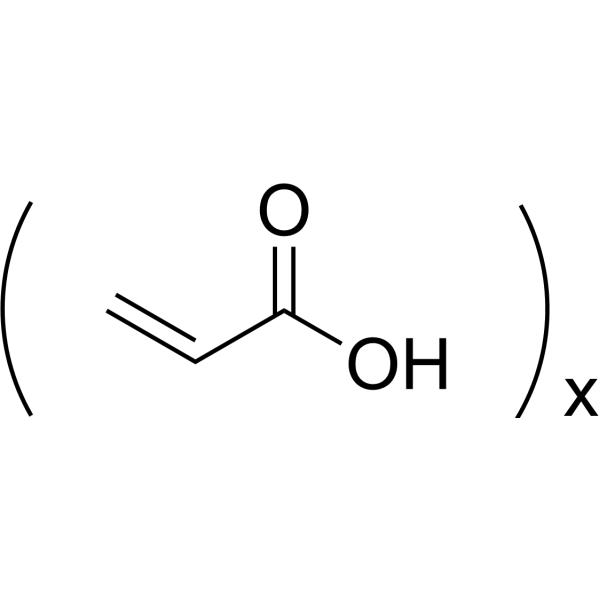Polyacrylic acid

Polyacrylic acid structure
|
Common Name | Polyacrylic acid | ||
|---|---|---|---|---|
| CAS Number | 9003-01-4 | Molecular Weight | 2000(Average) | |
| Density | 1.09 (30% aq.) | Boiling Point | 116ºC | |
| Molecular Formula | (C3H4O2)x | Melting Point | 106ºC | |
| MSDS | Chinese USA | Flash Point | 61.6ºC | |
| Symbol |

GHS08 |
Signal Word | Danger | |
Use of Polyacrylic acidPoly(acrylic acid) is a polyacrylic acid with a molecular weight of 2000. |
| Name | poly(acrylic acid) macromolecule |
|---|---|
| Synonym | More Synonyms |
| Description | Poly(acrylic acid) is a polyacrylic acid with a molecular weight of 2000. |
|---|---|
| Related Catalog |
| Density | 1.09 (30% aq.) |
|---|---|
| Boiling Point | 116ºC |
| Melting Point | 106ºC |
| Molecular Formula | (C3H4O2)x |
| Molecular Weight | 2000(Average) |
| Flash Point | 61.6ºC |
| Exact Mass | 72.02110 |
| PSA | 37.30000 |
| LogP | 0.25700 |
| Index of Refraction | n20/D 1.442 |
| Water Solubility | Soluble in water. |
CHEMICAL IDENTIFICATION
HEALTH HAZARD DATAACUTE TOXICITY DATA
|
| Symbol |

GHS08 |
|---|---|
| Signal Word | Danger |
| Hazard Statements | H340-H350 |
| Precautionary Statements | P201-P308 + P313 |
| Personal Protective Equipment | Eyeshields;Gloves;half-mask respirator (US);multi-purpose combination respirator cartridge (US) |
| Hazard Codes | C: Corrosive;T: Toxic;Xi: Irritant; |
| Risk Phrases | 45-46-34-36/37/38 |
| Safety Phrases | S24/25 |
| RIDADR | UN 3265 8/PG 3 |
| WGK Germany | 3 |
| RTECS | AT4680000 |
| HS Code | 3906909090 |
| HS Code | 3906909090 |
|---|
|
Cyclodextrin-crosslinked poly(acrylic acid): adhesion and controlled release of diflunisal and fluconazole from solid dosage forms.
AAPS PharmSciTech 14(1) , 301-11, (2013) The controlled release of diflunisal and fluconazole from tablets made of novel polymers, poly(acrylic acid) (PAA) crosslinked with either β-cyclodextrin (βCD) or hydroxypropyl-βCD (HPβCD), was invest... |
|
|
Cyclodextrin-crosslinked poly(acrylic acid): Synthesis, physicochemical characterization and controlled release of diflunisal and fluconazole from hydrogels.
Int. J. Pharm. 444(1-2) , 175-84, (2013) The aim of this work was to develop mucoadhesive hydrogels with variable drug delivery properties by crosslinking poly(acrylic acid) (PAA) with cyclodextrins (CDs). CD-PAA polymers with high CD conten... |
|
|
Chest wall reconstruction using biomaterials.
Ann. Thorac. Surg. 95(3) , 1050-6, (2013) Skeletal chest wall reconstruction can be a challenge, depending on the indication, location, and health of the patient; various materials are available. Recently, biomaterials that are remodelable (b... |
| PAA |
| Poly(acrylic acid) |
| Propenoic acid polymer |
| EINECS 618-347-7 |
| Acrylic acid polymer |
| MFCD00084394 |
| 2-Propenoic acid homopolymer |
| Carbomer 940 |
| Polyacrylic acid |
| Carbomer 934 |

